This post may contain affiliate links. Please see our disclosure policy.
Instant pot canning seems like a great idea, but is it really? The instant pot is a pressure cooker, but can it also be an electric pressure canner?
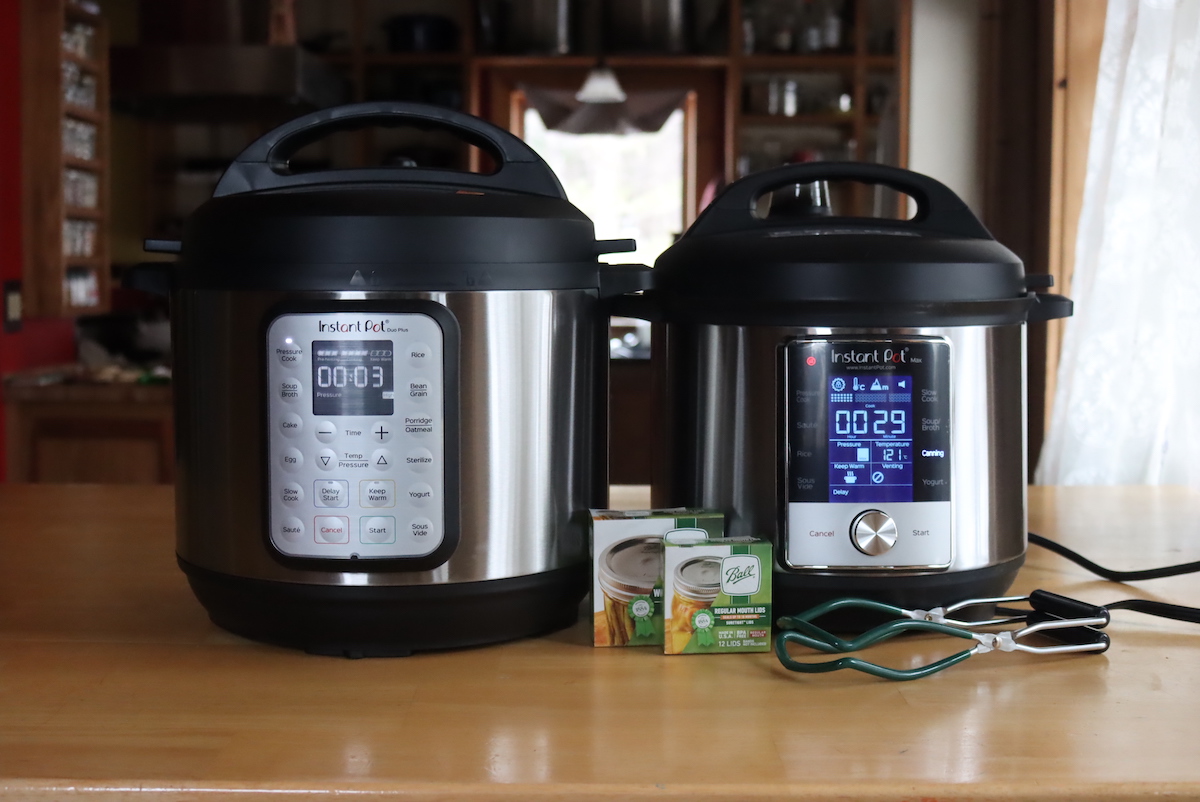
Table of Contents
- Is the Instant Pot Safe for Pressure Canning?
- What’s the Difference Between Water Bath Canning and Pressure Canning?
- How Does Pressure Canning Work?
- Why Can’t I Use a Pressure Cooker for Canning?
- Has the USDA Tested the Instant Pot for Pressure Canning?
- Canning in the Instant Pot Max
- Is the Instant Pot Safe for Water Bath Canning?
- Electric Pressure Canning Options
- Canning Guides and Reviews
Until the instant pot was released in 2010, most people didn’t know the first thing about pressure cooking (or pressure canning). These nifty little countertop appliances took the fear out of pressure cooking, and a whole generation of home cooks now enjoy tender meat and dry beans cooked quickly without soaking, right from their instant pot.
While the instant pot is a great way to get a meal on the table quickly, people soon began asking if it could do more. People use them to proof bread, make jam, and steam eggs. Now there are instant pots that make yogurt, and there’s even a whole book titled Instant Pot Cheese which has dozens of cheesemaking recipes for the instant pot. (Seriously, who knew you could make feta in that thing!?!?)
But the obvious question is, can you pressure can in an instant pot?
They are pressure cookers, after all. Why can’t I use a pressure cooker for canning?

Is the Instant Pot Safe for Pressure Canning?
No, the instant pot is not safe for pressure canning. This also includes the instant pot max, which has a canning setting. The marketing is a bit misleading, but when you refer to the instant pot website, they note that the canning setting on the instant pot plus is only approved for water bath canning jams, jellies, and pickles.
They acknowledge that instant pots are unsafe for pressure canning (as of 2023).
While instant pots can be used for water bath canning, which can preserve high-acid foods like jams, jellies, fruit, and pickles, they cannot be used as a pressure canner to preserve low-acid foods like meat, vegetables, and soups.
The instant pot is a pressure cooker, not a pressure canner, and there is a very important difference between the two (which I’ll explain in detail shortly). Before you can understand why an instant pot isn’t safe for canning, you first need to understand the difference between water bath canning and pressure canning, and then you need to understand how pressure canning works.
(While the instant pot isn’t safe for pressure canning, there is one electric pressure canner on the market (from presto canning) that meets USDA guidelines. I’ll discuss that one shortly as well).
What’s the Difference Between Water Bath Canning and Pressure Canning?
There are two main types of canning, and they include water bath canning and pressure canning. Water bath canning is used for acidic foods, while pressure canning is used for vegetables and meats.
The terminology gets tricky here, but keep this in mind:
- High-acid foods have lower PH numbers (less than pH 4.6)
- Low-acid foods have higher PH numbers (more than pH 4.6)
The lower the pH number, the more acidity there is in any particular food.
Water Bath Canning is used for preserving high-acid foods like jam, jelly, fruit, pie filling, and pickles. All things that are below a pH of 4.6. It involves submerging jars in a pot of boiling water for a specified processing time. Boiling water temperatures (212 F or 100 C) are hot enough to kill off mold and anything else that can live in a jam, but it’s not hot enough to kill off the really nasty things that could grow if the contents of the jars weren’t acidic.
Pressure Canning is used for foods with a pH above 4.6, such as meat, vegetables, soups, beans, and chili. Since you’re canning in a pressurized chamber, the temperatures can get much higher, and foods are processed above 240 F (or about 116 C). That’s hot enough to destroy pathogens that can live in jars when the pH is above 4.6, namely botulism spores, which can be deadly if not destroyed in the canning process.
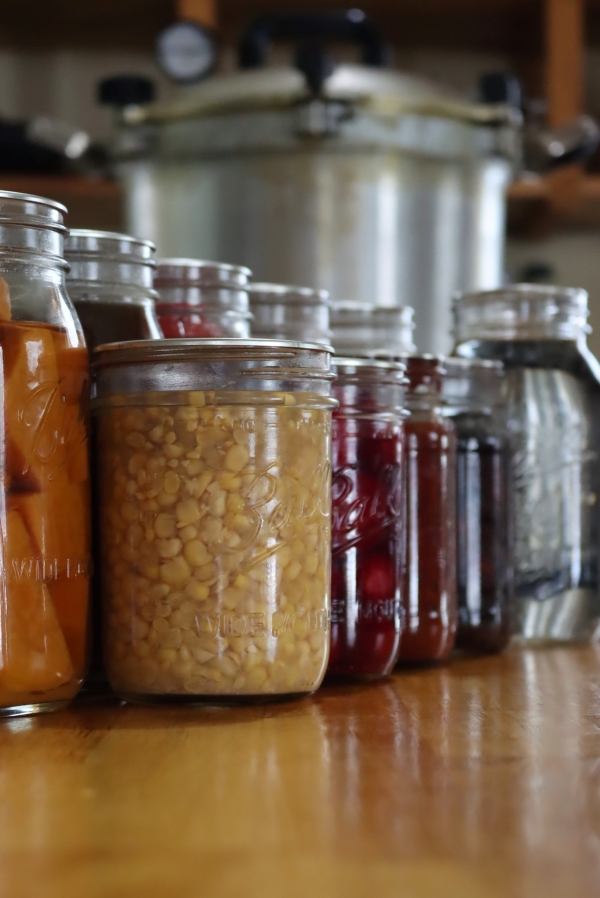
How Does Pressure Canning Work?
Pressure canning involves taking food to a very specific temperature (240 F, or about 116 C) and holding it at that temperature for a prescribed amount of time. The amount of time varies by the canning recipe, and it mostly has to do with food density. For example, you can process broth and stock much faster than you can process meats, veggies, and soups that contain solids.
Regardless of what you’re pressure canning, the temperature is always the same. That’s the temperature at which botulism spores are destroyed, and botulism is nothing to mess around with! It’s nasty, and it can be fatal, so you really need to make sure that low-acid food is processed in a way that kills the spores that could potentially cause botulism toxin in your jars.
Botulism can only thrive in low-acid (high pH) environments, so it’s not a problem with acidic pickles, jams, and jellies. They can be processed in a water bath canner (at 212 F or 100 C), which is enough to kill off any mold spores or anything else that might cause your jam to spoil. But anything that’s a low-acid food (above a pH of 4.6) needs to be processed at 240 degrees or above.
The pressure in the canner isn’t as important as the temperature, and 240 F is the magic number. Botulism spores can survive 239 F, but once things hit 240 and stay there for long enough, the spores are killed. Just reaching 240 for a few seconds is not enough; the pressure canning chamber must stay above 240 for the whole processing time, which can vary from around 20 minutes for pints of broth, up to 75 minutes for soup, and all the way up to 100 minutes for seafood.
If the temperatures drop below 240 during the canning process, you have to start the timer all over again to ensure safe processing. That’s very frustrating for home canners, and having an electric pressure canner that would maintain that temperature automatically would be incredibly useful.
(Spoiler alert, there actually is an electric pressure canner that does just that. It’s not an instant pot, though. It was developed by presto pressure canning in 2020, and it’s currently the only electric pressure canner on the mark that I recommend, and I’ve tried them all.)
At higher altitudes, it takes more pressure to reach 240 F, so altitude adjustments for pressure canning instruct you to increase the processing pressure if you’re above 1,000 feet in elevation. Those altitude adjustments are to ensure that you have enough pressure to hit 240 F, and while it only takes around 10 to 11 pounds of pressure to reach that at sea level, it can take 15 pounds to reach 240 F if you’re above 6,000 feet in elevation.
So, in a nutshell, pressure canning is all about sterilizing low-acid food (meat, beans, vegetables, etc.) for a specified time (20 min to 100 min) at sustained temperatures above 240 F.
Why Can’t I Use a Pressure Cooker for Canning?
Great, so now that you understand how pressure canning works, why not try canning in an instant pot?
An instant pot is designed to pressure cook foods that don’t require exact temperatures. It has only two settings, “high” and “low” and they don’t necessarily correspond to any particular psi or temperature.
The “low” setting on an instant pot will keep the chamber somewhere in a range between 4 psi and 7 psi. The heating element turns on for a bit to bring it up to 7-ish and then turns off for a while until it falls down to about 4. At that point, it kicks back on to bring it back up again. It’s a constant sine wave of temperature fluctuation, rather than a fixed temperature.
The “high” setting keeps foods between about 10 and 12 psi, which would almost be high enough for pressure canning at sea level. Almost, but not quite. You need 10.5 psi to hit 240 F at sea level, so every time the chamber dips down to 10 pounds it’s actually going below the safe processing limit.
That’s at sea level, though. Most of the country is above sea level, and at higher elevations, you need higher pressures to reach safe pressure canning temperatures. Here’s what’s required:
- 0 to 2,000 feet ~ 11 pounds pressure
- 2,001 to 3,000 feet ~ 12 pounds pressure
- 3,001 to 6,000 feet ~ 13 pounds pressure
- 6,001 to 8,000 feet ~ 14 pounds pressure
- 8,001 to 10,000 feet ~ 15 pounds pressure
Los Angeles County alone varies in elevation from sea level all the way up to 5,000 feet, and there’s no way to adjust for elevation using an instant pot.
(The instant pot max actually does have a screen that allows you to set elevation, but ironically, it doesn’t actually change the temperatures when you use the “canning” setting on the machine. I’ve tested this myself. The screen is displaying a calculated temperature based on pressure, rather than the actual temperature in the chamber. At higher altitudes, it’s not using more pressure. It runs the same cycle with the same pressure…it’s just displaying a lower temperature on the screen. It’s not actually measuring the internal temperature, which would be required to make appropriate altitude adjustments to pressure can in the instant pot. It’s just displaying what it guesses is the internal temperature as a little FIY because people love watching readouts on touchscreen displays. Funny that, but not helpful for pressure canning.)
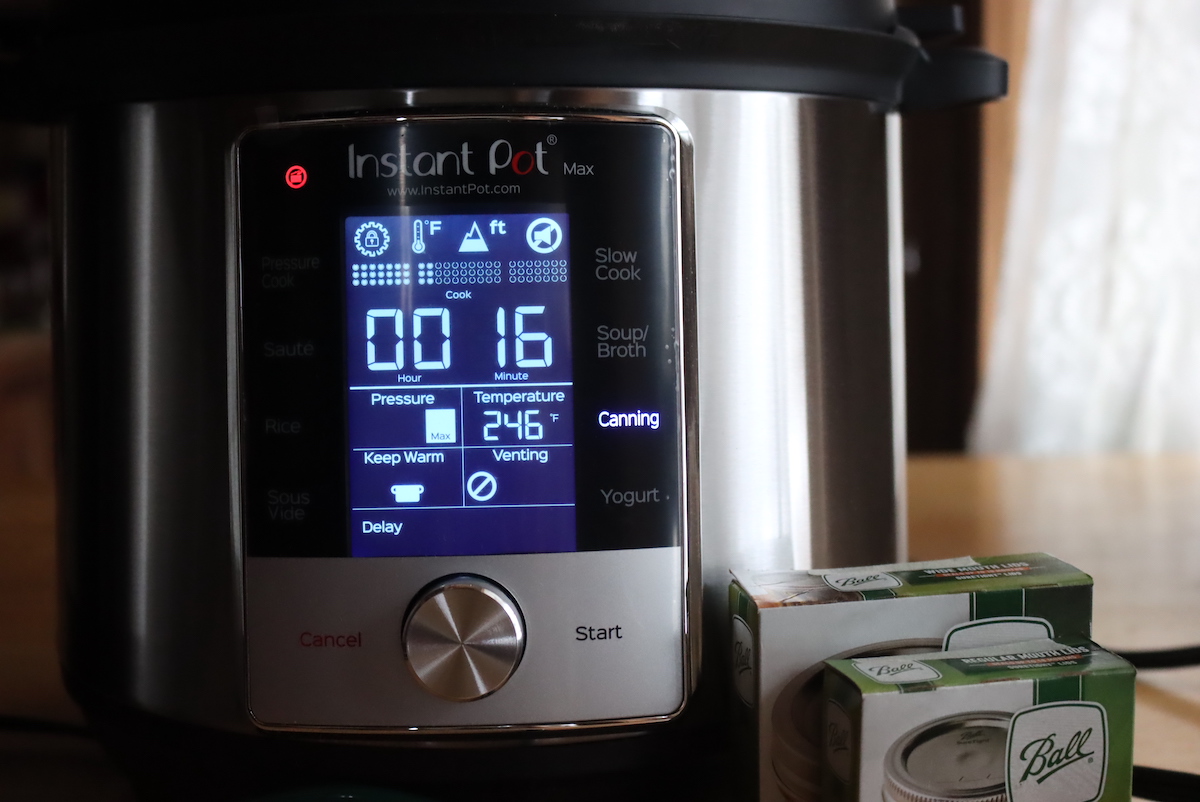
Even if, by chance, you do happen to live at sea level, it’s still not quite enough pressure to safely process low-acid foods. You’d have to actually live below sea level to make it work.
If you happen to live at the lowest point in the continental US (Badwater Basin in Death Valley, CA), you might be able to safely pressure can in an instant pot…but given that it’s a wasteland at the center of a national park, it’d be pretty unlikely that you happened to be pressure canning there.
(But if you are, send me a picture; it’d make my day to see it!)
Has the USDA Tested the Instant Pot for Pressure Canning?
Believe it or not, various county extension offices have tested instant pots for canning, and they found that they aren’t capable of adequately processing food.
In 2019, the Utah extension tested the instant pot (and various other competing multi-cooker brands) and found that none of them adequately processed foods for pressure canning. They tested chicken, pinto beans, and green beans…all of which failed at every altitude tested.
Beyond the temperature/pressure problem that I’ve discussed above, there are a number of other issues that the USDA cites with these small multi-cookers.
They put out a report in 2019 that says in no uncertain terms that canning in the instant pot is unsafe. They cite multiple reasons for this, primarily the inability of the cooker to hold the proper temperature, but also other really interesting reasons you might not have considered.
When processing times were established for pressure canning, they made a few key assumptions largely because stovetop canners were the only ones on the market at the time. Namely, the chamber size and the amount of time it takes to heat and cool.
Very small pressure chambers, like the instant pot, heat and cool faster than stovetop canners. Even if they were capable of maintaining the right pressure, the chamber is actually too small to use the established processing times per the USDA:
“One of the big concerns is that the USDA low-acid pressure process times rely on a combination of heat from the time the canner is coming to pressure, during the actual process time, and then during the early stages of cooling the canner and jars. Even after the heat is turned off under the canner, at the end of the recommended process time, the food remains at high enough temperatures for another period of time that can still contribute to killing of bacteria. This retained heat while the canner has to cool naturally to 0 pounds pressure before opening is used to advantage in calculating the total sterilizing value of the process to preserve some food quality. If anything is done to shorten the cooling period, including using a very small cooker, then the food could cool down more quickly, and be under-processed. (That is why we recommend using only pressure cookers that hold four or more quart-size jars.) Bacteria are not killed in the food only during the process time; the time it takes the canner to come up to pressure, the process time, and the cool-down time all matter. There is no way at this point in time to know exactly the percentage of contribution from cooling for each of the canning recommendations.”
Since the chamber is not adequately vented before canning, they also note that the temperature may not be appropriate inside the instant pot even if it were able to maintain consistent pressure. If the chamber is not fully saturated with steam before the processing time, the actual temperature is lower than the required level. Again, per the USDA:
“What matters is temperature, not pressure. One manufacturer says its cooker reaches the pressure required for canning, but that alone does not prove the food in the jars is heated throughout at the same rate as in the canner used for process development. A manufacturer should do process development work to document temperatures throughout the unit at a given pressure and throughout the whole process time. Just producing an interior pressure is not sufficient data for canning recommendations. For example, if air is mixed in the steam, the temperature is lower than the same pressure of pure steam. That’s why a proper venting process is so important in pressure canning – to obtain a pure steam environment inside the canner. Also, one has to know how to make adjustments in pressure readings at higher altitudes. The same pressure and process time combination cannot be used at all altitudes.”
Canning in the Instant Pot Max
But wait, what about the Instant Pot Max? That’s an instant pot that’s approved for canning, right? It has a canning setting!?!? How could it not be safe for pressure canning?
This one’s actually an unfortunate mistake that the marketing team at instant pot quickly walked back after it was released. The instant pot max does, in fact, hit a maximum psi of 15 pounds pressure, but then it cools and maintains a pressure of 10 to 12 psi for the rest of its cycle.
Instant pot actually has a really nifty graphic that shows the pressure inside the instant pot max as it works:

Each time it cools enough to turn on the heating element, the instant pot max is actually dipping below safe processing pressures at sea level. If you’re just a few thousand feet above sea level, 12 psi is also below the safe processing temperature.
Right when the instant pot max was released, the PR team at instant pot said, “Of course, you can pressure can in an instant pot!” But then, when questioned, it quickly became clear that the developers of that setting didn’t realize that just hitting 15 psi once for a few seconds wouldn’t be enough. You need to maintain pressure for the whole processing cycle to safely pressure can.
Later, when they realized this, representatives from instant pot then said that they were having McGill University test the canner to ensure that it met safe pressure canning guidelines. That was in 2018.
Nothing public ever came out from McGill University, and then instant pot changed its marketing materials a few years later. Now, in 2023, if you look at the instant pot website, it says this about the “canning” setting on the instant pot max:
“Pressure canners require a minimum of 15 psi for safe canning of low-acid foods, such as meat.
Most Instant Pot electric pressure cookers operate within a range of 10-12 psi, which is safe for water bath canning of high-acid foods, such as jams and chutneys.
Modifying cooking times, ingredients, or temperatures can be dangerous. Use the exact time, temperature/pressure, and method specified in the recipe to protect the food from harmful bacteria, molds, and enzymes. Read and carefully follow the instructions provided in the USDA’s Complete Guide to Home Canning.
The Instant Pot Max is the only electric pressure cooker with a dedicated Canning Smart Program.”
They are, in fact, carefully dancing around the fact that they made a mistake.
The “smart canning program” or not, their “canning” setting is not for pressure canning. They now acknowledge on their own website that the instant pot max is only approved for water bath canning.
Is the Instant Pot Safe for Water Bath Canning?
Since the instant pot can, in fact, boil water dependably, it can be used as a water bath canner. But honestly, anything that can boil water can be used as a water bath canner. Any saucepan on the stove that’s deep enough to submerge the jars can be used for water bath canning.
It is nice that you can do it in a sealed chamber in the instant pot, so you’re not dealing with steam in your kitchen, but the instant pot isn’t actually doing anything that a little boiling water on the stove wouldn’t accomplish.
In fact, if you do process jars in your instant pot, it can actually hurt the quality of the foods inside the jars. At noted above, the instant pot max reaches pressures of 10 to 12 psi, which while not hot enough for pressure canning, is much hotter than a boiling water bath canner.
At those temperatures, the pectin in jam starts to denature, and you can actually ruin your jam. If you’re canning pickles in there, they will be soggy mush. Pickles are a special food that can actually be processed using low-temperature pasteurization at 180 degrees F since there’s so much vinegar involved. Using low temperatures helps keep them crisp, and putting those tender cucumbers into the instant pot will over-process them into mush.
I do not recommend using the “canning” setting on your instant pot, even for water bath canning. If you want to use your instant pot for water bath canning, fill the pot enough to submerge the jars and then use the “saute” setting to bring it to a boil. Be sure you use a canning trivet below the jars, as the intense heat from the heating element through the thin lining of the instant pot internal pot is enough to break jars.
Electric Pressure Canning Options
Don’t get me wrong, I love my instant pot!
It’s an incredibly useful countertop appliance, and I use mine all the time. But it’s not a pressure canner.
You should know that canning in an instant pot is like playing Russian roulette. Botulism spores need to be present to cause a problem, and honestly, most of the time, they’re not. That’s why you can get away with canning in an instant pot occasionally and not getting your family sick, at least a few times.
But eventually, if you play Russian roulette long enough, your number comes up. Processing food below safe processing temperatures will catch up with you eventually, and you shouldn’t fool yourself into thinking that an instant pot is a safe way to process low-acid foods.
While the instant pot isn’t safe for pressure canning, there is a model of electric pressure canner that came out in 2020 that meets the USDA guidelines for safe pressure canning. The Presto Precise Digital Pressure Canner is easy to use, and it’s the only electric pressure canner I recommend at this point. (Here’s where you can read my full review of the Presto Digital Pressure Canner and here’s where I walk you through how to use an electric pressure canner step by step.)
It doesn’t have a “pressure” setting, but instead, it just continuously monitors the temperature inside the chamber to ensure that it’s above 240 F. That means you don’t have to make any altitude adjustments at all, the canner does it automatically.
The presto canner also walks you through each step of the canning process, and won’t let you proceed until you’ve properly warmed the jars and vented the canner. It really makes the whole process seamless, especially for beginning canners.
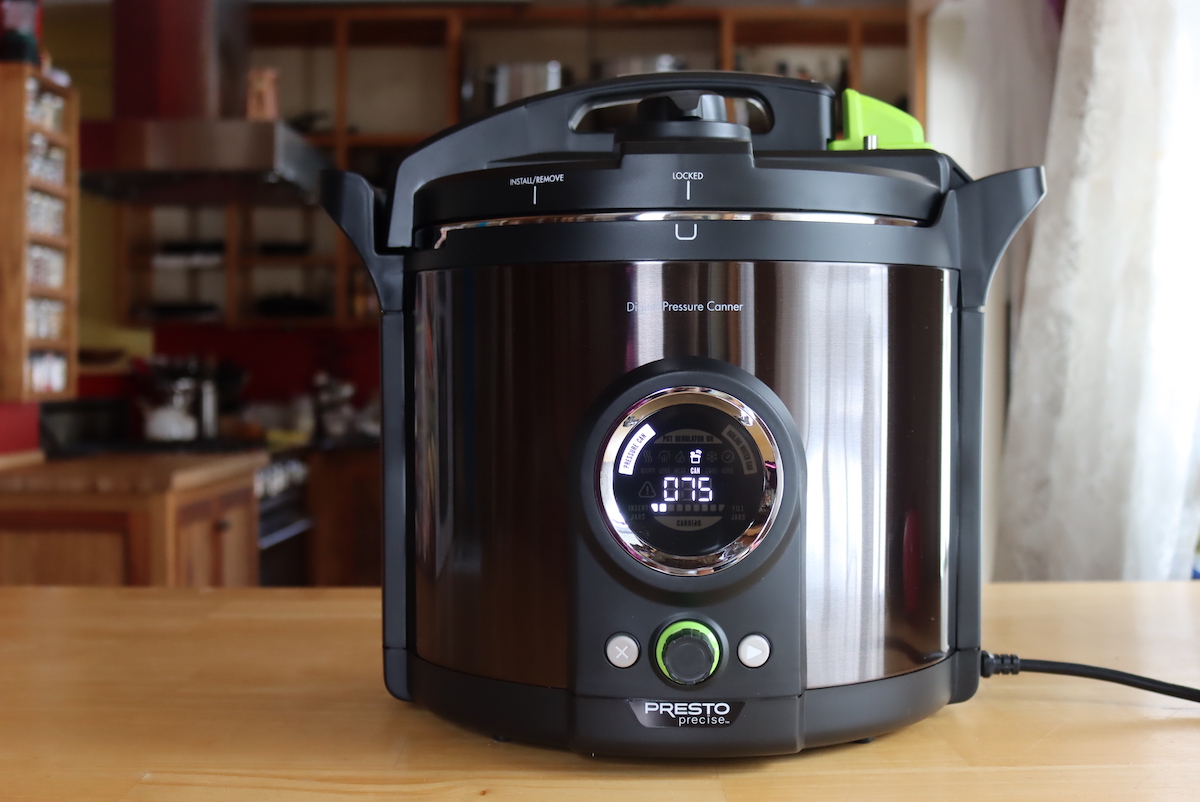
I’ve been pressure canning for more than a decade now, and I’m incredibly excited about this new electric pressure canner. I can whip it out after dinner and quickly process leftovers without a fuss. It beeps to prompt you at each step, but beyond that, it runs in complete silence, all automatically powered by a standard wall outlet.
Any experienced pressure canner knows that canning is a noisy affair, with the canning weight constantly jiggling or constantly having to monitor and adjust the stove temperature to ensure safe processing. With this electric pressure canner, once the jars are processing, everything is completely hands-off.
This thing is going to completely revolutionize home food preservation, and I’m so excited that it’s going to open up pressure canning to a whole new generation that’s comfortable with the instant pot, but terrified of pressure canning. The nice thing about it is that it’s just as easy to use as a regular instant pot, and just as “not scary” as those same electric pressure cookers that we’ve all become comfortable with over the past decade.
Do not attempt to pressure can in an instant pot; it doesn’t reach the appropriate temperatures for safe pressure canning. If you are looking for a good option for easy, dependable, not scary pressure canning, invest in the Presto Precise Digital Pressure Canner.
(I am not in any way associated with Instant Pot or Presto Canning, and I bought these with my own money for this review. My opinions are my own, always.)
Canning Guides and Reviews
Looking for more canning guides and information?
- Beginner’s Guide to Pressure Canning
- How to Use an Electric Pressure Canner
- Presto Precise Digital Pressure Canner Review
- What is Canning Salt? (And Substitutions)
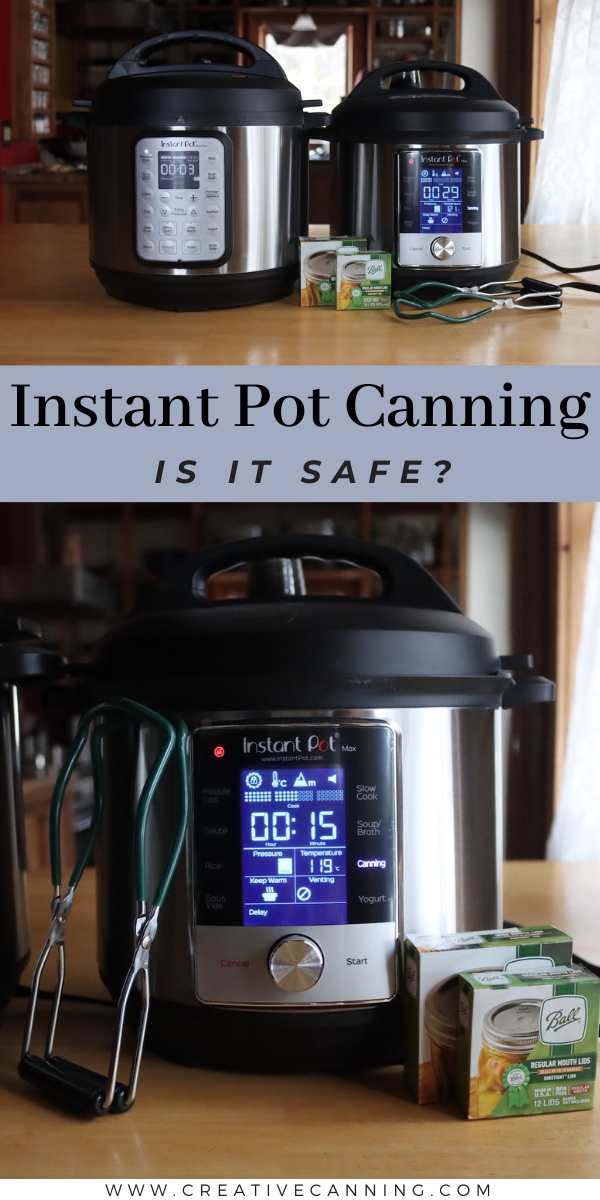
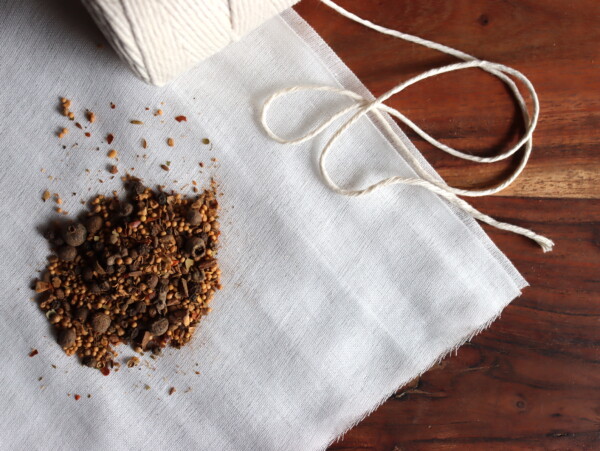

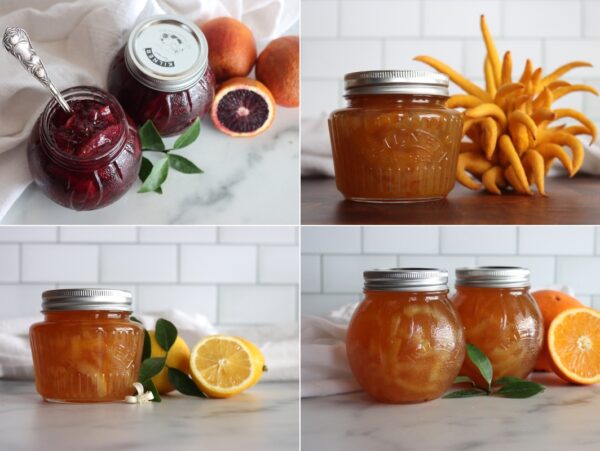
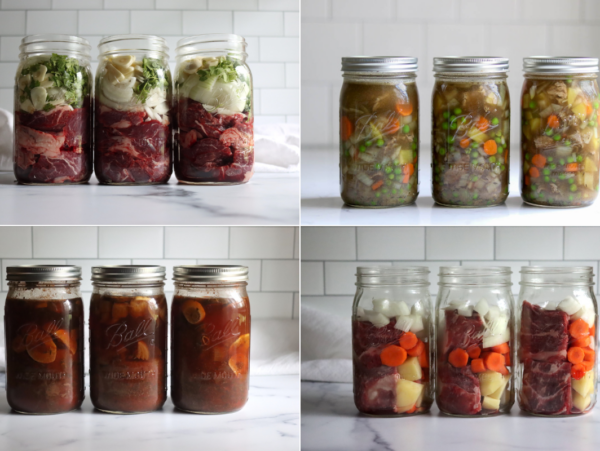
Well, I certainly wish I had stumbled across this blog post sooner because there are still a few Instant Pot Max floating around out there in 2025 and I just bought one! (After seeing a customer Q&A on Amazon where someone asked what models could be used for canning and Instant Pot responded that the Max and the Pro models could reach 15 psi.)
Although I get the particular concerns for low-acid food at high elevation, I can’t seem to find any testing that was done after these safety concerns were raised.
I did see the following posted in 2023 to a FB group, but again no source for where the “test data” can be found. Among other things it says, “The Instant Pot Max and Pro Plus canning settings operate at higher temperatures for extra safety. Certain foods may appear overcooked.” And near the bottom of the statement, this: “The real-time display of the internal temperature will indicate to the user whether the desired safe canning temperature can be sustained”.
Here is the complete quote:
“Test data confirms that the Max and Pro Plus models operate at required temperature ranges that can perform canning of the entire spectrum of foods as per USDA home canning guidelines. It is important that recipes are closely followed when canning. Modifying cooking times, procedures, ingredients, or temperatures can be dangerous.
Please follow the USDA published guidelines & recipes for home canning.
The “Low Pressure” setting on the Instant Pot Max and Pro Plus can sustain a temperature range of 230-231°F / 110 – 111°C for canning of high-acid foods.
The “Max Pressure” setting on the Instant Pot Max and Pro Plus can sustain a temperature range of 242-247°F / 116 – 119°C for canning of low-acid foods.
USDA canning instructions for high-acid foods are based on a 212°F / 100°C setting, and low-acid foods are based on a 240°F / 115°C setting. The Instant Pot Max and Pro Plus canning settings operate at higher temperatures for extra safety. Certain foods may appear overcooked.
The canning guidelines are based on the condition of up to 4,921ft / 1500 m altitude. At higher altitudes, the steam release may be activated to control the internal pressure to a safe level. The real-time display of the internal temperature will indicate to the user whether the desired safe canning temperature can be sustained. Users should observe this important guideline (or restriction) to ensure food safety in the home canning experience.”
If Instant Pot was among the first to enter the electric canning space, a healthy amount of skepticism is to be expected. But as a first, I would also expect that Instant Pot would have been under a greater set of challenges to test for safety before bringing it to market since there would have been few or no predecessors to build upon. But supposing they got all the way to the manufacturing and marketing stage without bothering with USDA food safety guidelines, why haven’t these early “canning” models been recalled? Instead, as you observe, they are merely “dancing around” the admission that they are not suited for canning.
This is a sticking point for me: How can Instant Pot can fudge something this serious as whether the canning function is safe to use given not only the public health risks but how litigious a society we live in? After all, we can’t even see a plastic bag without warnings regarding suffocation risk — so if anything I would have expected the Max to be A) not just discontinued but recalled. (Heck, even my Vitamix blender was subject to a safety recall that involved nothing more than issuing an added safety shield in case one of the blender attachments shattered); or B) Instant Pot by now would have issued a strongly-worded statement on the Instant Pot website that canning function is NOT to be used. Since neither one of these is true and Instapot Max seems to have been discontinued much like any other number of models have, I have to assume the company lawyers did not get more involved because the product is not as unsafe for the purpose of canning as its social media reputation would suggest.
As an example, I read an old CNET product review for the Max that brought up the same concerns about USDA canning guidelines compliance, which in turn linked to the university you stated where a safety study was said to have taken place. The URL still refers to electric pressure cooker canning but the page is entirely blank. Why take their findings down if these “canning” pressure cookers are still floating around out there — either operable in consumer homes or still being sold here and there new in a box?
In my view, the only explanation for why the data is missing is because the data did not prove the conclusion that electric canning was unsafe — otherwise it would be incumbent upon the Consumer Product Safety Commission or any other number of government agencies to make sure, under no uncertain terms, that these units were physically recalled. (To cite another example, a member of my household uses a C-PAP machine built by Phillips, the same company that makes electronic shavers and other equipment. When that was recalled in 2020, Phillips had owners physically ship the units back over a two year period for physical destruction. One would think the risk of being poisoned by a faulty electric food canning function would warrant the same level of response — unless it is all in the realm of theoretical shortcomings — i.e. it’s 15 PSI max, not sustained, therefore it allows the temperature to become too cold for low-acid canning — as opposed to proven harms (i.e. some sickened Max or Pro owner somewhere sued Instant Pot and won).
In conclusion, while I was drawn to the Max because I have young fruit trees and hopes of eventually canning the results I honestly don’t know if I will ever use the Max to can anything (it never even occurred to me to try canning meat). Another draw for me is that I can’t can on a stove-top because I live in an all-electric home. (Gas-free homes and all-electric appliances are the future so I am afraid this is all something we will all face sooner or later.) So is my Instant Pot Max really going to kill me? Or did it’s potentially dangerous reputation precede it so swiftly and early because Instant Pot’s real mistake was not divulging how they safety tested?
I know this is a lot to take in on a comment but I’m really lost! Thanks.
Very informative article! I don’t have an instapot and I’m not a pressure canner. However, my MIL cans and so I’m rather curious. Now I know what the limitations are. Maybe I should ask for BOTH the instapot and the electric pressure cooker for Christmas this year. 🤣
I was just reading through your article on whether an instant pot can be used for canning. Early on in the section where you talk about the differences between water, bath and pressure canning, in the section on pressure canning, you mention that botulism can be deadly. I think you missed the word not in that sentence at the end of the paragraph.
I did find the article very informative, at least as far as I read ( which looks like it wasn’t far after scrolling down to the bottom)
Thank you for catching that! Fixed now, and it now reads:
“That’s hot enough to destroy pathogens that can live in jars when the pH is above 4.6, namely botulism spores, which can be deadly if not destroyed in the canning process.”
Nice, clear article about something I’ve wondered about for some time. Minor erratum: there are a few places where you get ‘above’ and ‘below’ confused on pH, like the example below (I frequently the same mistake 🙂
===
Pressure Canning is used for foods with a pH below [I think you mean above, i.e., less acid] 4.6, such as meat, vegetables, soups, beans, and chili.
Thank you so much for catching that, I’ve fixed it now and I appreciate your note so I could get it right!